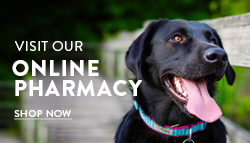Feeding Your Pet
A healthy and balanced diet is essential for a healthy and happy pet. Not only will it provide your pet with enough energy for his day to day activities, but it is also vital for proper brain function. An adequate diet is also particularly important for animals in the early stages of their development.
One of the most important things to remember when it comes to feeding your pet is to feed them by ‘life-stage’. Different animals, and in particular cats and dogs, require different nutrition at different stages of their life. For example, puppies around 12 weeks of age will require around 3 meals a day and it is not until they reach around 6 months of age that this amount should be reduced. That said, your animal may prefer smaller and more frequent meals. They key to feeding your pet properly is understanding what works best for them.
Methods of Feeding
A popular method of feeding is known as ‘free-feeding’. This is where a bowl of food is left out so that a pet can eat as much or as little and as frequently as they prefer. This works best for dry foods since they do not spoil as quickly as the wet variety. Some studies show that this method results in over-eating and subsequent pet obesity. However it may be the best option for you if you cannot stick to a feeding schedule.
Scheduled portioned feeding requires a strict routine that you need to be able to guarantee to stick to. Your pet will know when meal times are and ensure that they are ready for them, with cats coming indoors specifically at these times. This method limits the amount that your pet eats either by portion size or by time as some pet owners prefer to give their animals a specific time frame in which they must eat. This method also works well if you have pets that required medication to be mixed with their food, or have an animal on a calorie-controlled diet.
If you are unsure which method is right for your pet, consult with your veterinarian who will be more than happy to provide advice.
General Feeding Advice
Do NOT offer home cooked meals or table scraps. These may not meet the complex nutritional needs of your pet. Many food items that humans eat are toxic to dogs and cats. Instead stick to especially formulated pet foods that have been designed to offer an entire complete and balanced diet in a single product.
Always choose a diet that is labeled with the AAFCO seal and avoid any diets that contain one or more dyes(i.e. Red 40, Yellow 5, etc). Artificial coloring adds no nutritional value, and in some cases, has been associated with damage to organs and even cancer.
Many pet food companies would like you to believe grain-free is a necessity for most pets, but remember, most food allergies are actually due to a protein source, not corn, wheat or other popular grain ingredients.
Dogs
There are many myth’s surrounding ingredient choices used in dog food. Your veterinarian can help you choose a quality diet that is safe and fits your budget.
Dogs should be kept on the same brand and type of food as much as possible. Regularly changing them could cause him to have an upset stomach. If you do have to change then try and introduce the new food gradually so that your dogs’ digestive system has a chance to adjust.
Cats
To cats the odor of their food is particularly important and they prefer their food to be around body temperature when they consume it. Shallow, glass or ceramic bowls do not absorb externals odors and are the best choice for feeding. They also like to be able to see their surroundings when they eat and not backed into a corner.
Cats naturally prefer grazing on small meals and so dry food free-feeding is often the most popular choice for mealtimes, but this can lead to severely overweight cats and many owners have a hard time recalling exactly when their sick pet first became disinterested in meals. If possible, feed your cat multiple times a day, picking up any uneaten food after 30 minutes.
Protein and fats are the most palatable types of food for cats and they much prefer the texture of meat to anything else.
Your veterinarian will give you guidance on which diet to choose for your cat. Feeding a hard kibble is the best way to prevent obesity and periodontal disease. It will be helpful to offer canned or moist food occasionally, as a treat, to familiarize your cat with it in case your pet needs to use it in the future due to disease or to take medications.






